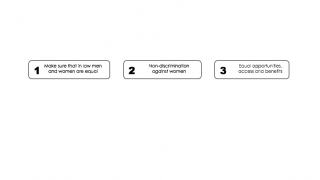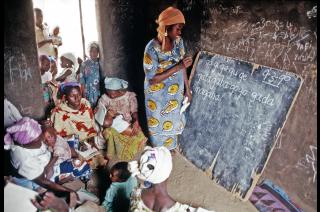Every year, 8 March is celebrated around the world as International Women's Day. It marks the struggle for gender equality that has gone on for many generations. The day has been celebrated since the early 20th Century by women in North America and across Europe campaigning for women's rights to work, vote, hold public office and for an end to discrimination. Today, thousands of activities occur on the day to mark the economic, political and social achievements of women across the world.
The United Nations has marked International Women’s Day since 1975 and each year the UN focuses on a different theme. In his message to mark the day in 2014, the UN Secretary-General Ban Ki-moon said: “Realising human rights and equality is not a dream, it is a duty of governments, the United Nations and every human being. The evidence is clear: equality for women means progress for all.”
Women, development and progress
“On my travels around the world, particularly to its poorest and most troubled places, I have learned that it is mothers who keep families together – indeed, who keep entire societies intact. Mothers are society’s weavers. They make the world go round. Yet too often, the world is letting mothers down.” Ban Ki-moon
Overall, there are slightly fewer women than men in the world. For every 100 women, there are 102 men.[1] However, this ratio does not apply to all age groups. There are more boys and men in the younger age groups and more women are in the older age groups. There are also big variations between the different regions of the world. Some regions, like Europe, have a ‘shortage’ of men, while other regions, such as South Asia, have a ‘shortage’ of women.
Women contribute enormously to a country’s economy and are integral to the development and progress of society as a whole. For example, female secondary school attendance is linked to growth in a country’s economy. Yet girls are often kept from receiving education in the poorest countries.
- According to the UN report The World’s Women 2010, women spend at least twice as much time as men on domestic work, and when all work – paid and unpaid – is considered, women work longer hours than men do.
- Worldwide, the “gender gap” in labour force participation remains considerable at all ages except the early adult years.[2]
- In the UK, men have consistently higher employment rates than women above the age of 22. Men also make up the majority of workers in the top 10% of earners for all employees but the gap is lower for those under 30.[3]
- A 2014 study from the Organisation for Economic Co-operation and Development (OECD) showed that British women spent 258 minutes per day on unpaid work such as housework, caring for relatives and food shopping. British men in comparison only spent 141 minutes a day on the same tasks.[4]
Despite the progress that have been achieved since International Women’s Day was first celebrated over 100 years ago, major challenges. There is still a long way to go before girls and boys, women and men have equal rights and opportunities.

UN Convention on the Elimination of All Forms of Discrimination against Women
To protect and promote the rights of women, the members of the United Nations adopted an international treaty – the UN Convention on the Elimination of All Forms of Discrimination against Women (CEDAW) in 1979.
Equality is a human right and one already included in documents such as the Universal Declaration of Human Rights and the International Covenant on Civil and Political Rights. So why was it necessary to create a treaty specifically on women’s rights?
The UN recognised that a separate treaty was needed to target the deep-set discrimination that women across cultures, societies and countries experience. The Convention, also referred to as the International Bill of Rights for Women, defines discrimination against women and sets up an agenda for national action to end it in all its forms.
Rights mean very little unless they are put into action. The Convention applies a three-pronged approach to ensure that governments make equal rights for women a reality, in the home and in the workplace.

Women, peace and security
In times of conflict, women and girls make up the majority of those forced to flee their homes into unstable environments. Often, they fare worse than men, vulnerable to sexual violence and unable to support their families due to restrictions on women’s ability to work and own property.
- Since 1990, approximately nine out of 10 casualties resulting from conflict were civilians. Of these, three out of four were women and children.
Women and girls are not just passive victims. They led peace movements and driven recovery efforts after conflict, even though they are rarely included in peace negotiations. To recognise that women’s participation is vital to achieving and maintaining peace, the UN adopted a major decision – Resolution 1325 – in 2000. It is also doing more to ensure that women play an active part in the UN peacekeeping efforts across the world.
- Between 1957 and 1979almost no women served as UN peacekeepers[6] Today women make up 3.8 percent of the military personnel and 10% of the police personnel in peacekeeping operations, while the number of women deployed as civilians such operations has reached 30 percent.[7]
UN Women
In 2010, the UN created a brand new agency to coordinate its work on gender equality and the empowerment of women. The first Executive Director was Michelle Bachelet, the first female President of Chile. Ms Bachelet’s successor was Phumzile Mlambo-Ngcuka, who is the former Vice President of South Africa. She is now tasked with leading the UN Women’s work to help governments to create laws and implement practical policies to improve the lives of women and girls.
UN Women is also responsible for ensuring that the UN lives up to its ideals. While there is gender parity at the lower professional grades of UN staff, only 27 percent of staff are women at the highest level.[8] This shows how ingrained the challenges to gender equality are, even within organisations like the UN.

